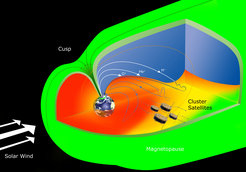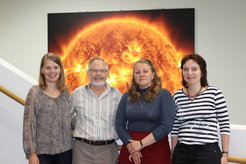Turbulence brings together Germany, Ukraine, and Russia
Elena Kronberg from the MPS wins grant to study space plasma in a trilateral cooperation.
While the relations between Ukraine, Russia and Germany are in a turbulent state, three scientists from these countries joined their forces to study how turbulent magnetic and electric fields in space accelerate charged particles to high energies. Such energetic particles can disturb the function of communication and navigation satellites, and a reliable prediction of these events is vital to minimize the damage. The three group leaders - all of them female - recently initiated their project with a meeting in the Max Plank Institute for Solar System Research (MPS) in Göttingen. For their project they are making use of the rich data set from the Cluster mission of European Space Agency which provides measurements of the Earth’s electro-magnetic field and charged particles. The Volkswagen Foundation is funding their project for 2 years with a total amount of 235.000 Euro.
Space plasmas still present puzzles to the scientific community. Their impulsive energy release events challenge our understanding of how efficiently energy in plasmas is transformed from one form to another. A key region where such events happen lies within the so-called magnetotail, a region located behind the Earth as seen from the Sun, where the Earth’s magnetosphere is stretched out. There, the magnetic energy supplied by the solar wind is accumulated and then explosively released. This results in strong heating of the plasma and acceleration of particles. The particles' energies, which can be boosted thousand fold, determine the near-Earth space weather. However, the causes that are responsible for such efficient energy release are still poorly understood.

Plasma with the low density that prevails in the interplanetary space cannot be reproduced in laboratories; therefore the best way to study it is through spacecraft observations in the Earth’s magnetosphere. Such observations are provided by ESA’s Cluster mission, a group of four satellites which were launched in 2000. Onboard the satellites, there is the RAPID spectrometer which was partly developed and built at the MPS. The RAPID instrument is a particle detector that allows distinguishing between different ions. By using its data the scientists will to study how the plasma composition and the distribution of particle fluxes influence the occurrence of explosive energy releases. “The MPS offers the unique opportunity for us to work directly with data from RAPID,” explains project leader Elena Kronberg. The observational work is then complemented with theoretical calculations. There, the experience of the collaborating group leaders, Dr. Liudmyla Kozak from the Space Research Institute in Ukraine and Dr. Elena Grigorenko from the Space Research Institute of the Russian Academy of Sciences comes into play.

“It was not easy to bring this project to life because of the turbulent political situation”, says Dr. Kronberg, scientist at MPS. “But going through difficulties and devoted interest to plasma physics help us to better understand each other and conceive new scientific ideas,” she adds.
Elena Kronberg has studied at the Altai State University, Barnaul, Russia and received her doctorate from the Technical University of Braunschweig. Since 2006 she works on the Cluster/RAPID project at the MPS.
In this call for proposals of the Volkswagen foundation, a total of 8.6 Million Euro was awarded to 39 research projects with disciplines ranging from engineering to natural sciences to social sciences. The Volkswagen Foundation initiated this one-off call for proposals, according to an announcement on their webpage, to strengthen cross-border cooperation between scholars, scientists, and academic institutions from all countries involved.

